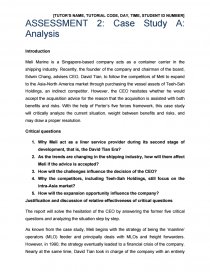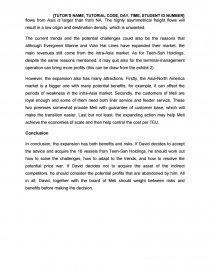Analysis on Meli Marine Company
Essay by 子轩 黄 • October 5, 2015 • Essay • 956 Words (4 Pages) • 2,696 Views
ASSESSMENT 2: Case Study A: Analysis
Introduction
Meli Marine is a Singapore-based company acts as a container carrier in the shipping industry. Recently, the founder of the company and chairman of the board, Edwin Chang, advises CEO, David Tian, to follow the competitors of Meli to expand to the Asia-North America market through purchasing the vessel assets of Teeh-Sah Holdings, an indirect competitor. However, the CEO hesitates whether he would accept the acquisition advice for the reason that the acquisition is assisted with both benefits and risks. With the help of Porter’s five forces framework, this case study will critically analyze the current situation, weight between benefits and risks, and may draw a proper resolution.
Critical questions
- Why Meli act as a liner service provider during its second stage of development, that is, the David Tian Era?
- As the trends are changing in the shipping industry, how will them affect Meli if the advice is accepted?
- How will the challenges influence the decision of the CEO?
- Why the competitors, including Teeh-Sah Holdings, still focus on the intra-Asia market?
- How will the expansion opportunity influence the company?
Justification and discussion of relative effectiveness of critical questions
The report will solve the hesitation of the CEO by answering the former five critical questions and analyzing the situation step by step.
As known from the case study, Meli begins with the strategy of being the ‘mainline’ operators (MLO) feeder and principally deals with MLOs and freight forwarders. However, in 1990, the strategy eventually leaded to a financial crisis of the company. Nearly at the same time, David Tian took in charge of the company with an entirely different scheme. During the David Tian era, Meli focused on intra-Asia exports with liner service, and it extremely treasured satisfaction of its customer. Additionally, the investment in specialized containers provided Meli with the ability to transport perishable or chemical goods. As nearly no competitor can offer same service, Meli is equipped with a strong bargaining power. Moreover, the case illustrates that the customers of intra-Asia liner service are very loyal to Meli. This situation suggests on a high entry level favored by Meli.
The revenue and gross profit row of exhibit 5 suggest that the ‘liner service’ does work in the past decade, but the current trends may shift the condition. There are three major trends, including possibility for overcapacity, require for bigger ships, and increase in competitive intensity. Three of the competitors somewhat diversified their services to decrease the influence brought by the trends. For example, one of the three competitors, Evergreen Marine, has diversified in to container manufacturing, vessel leasing, and container terminals. If Meli purchased the 16 vessels instead of diversifying into other parts of the shipping value chain, it may face a long-term overcapacity. Moreover, the 16 vessels are not so called bigger ships, as the average capacity is 4,500 TEUs each. Furthermore, the formal associations -conference- are not so powerful, which means the descending in the bargaining power of the container carrier. If David accepts the advice, all of the above may leave the company on an insecure financial footing again.
...
...



